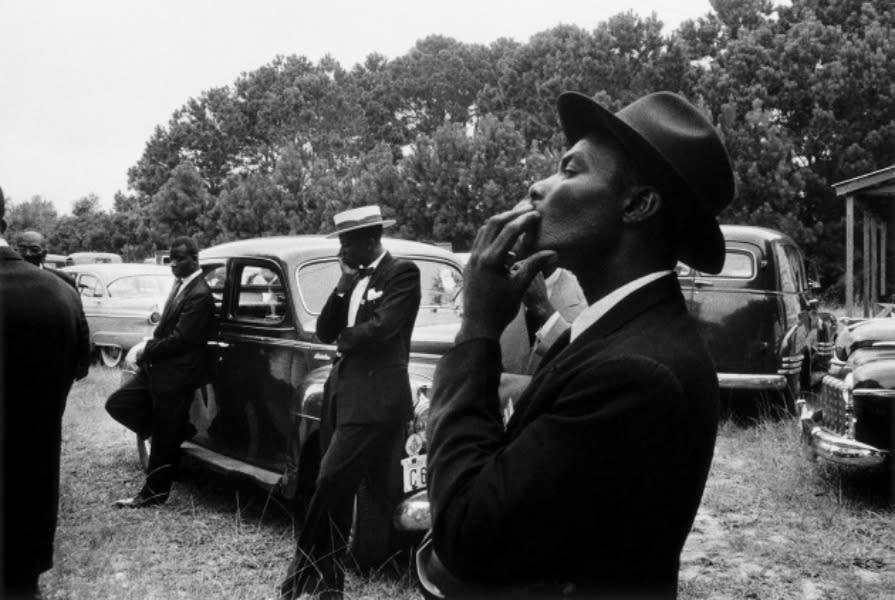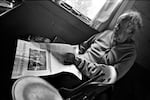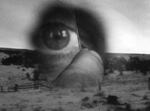
Robert Frank, Funeral - St. Helena, South Carolina, from the book The Americans © Robert Frank
Courtesy of Blue Sky Gallery
In 1959, Robert Frank’s book “The Americans” changed the course of photography.
Before it, photos had been used to illustrate newspapers and books, but had never appeared on their own.
“He had the idea to make a book without any text: just photos that speak for themselves,” said Gerhard Steidl, the world’s preeminent publisher of photography books. “His photography is more social reportage of humans and circumstances of people who live in the United States.”
Frank crisscrossed the country, capturing images of everyday people with an emotional authenticity rarely seen before by shooting from the hip and the shoulder instead of the eye, earning him comparisons to Alexis De Tocqueville and the reputation of being the inventor of street photography.
“He’d get the real life on his film,” Steidl said. “This technique was — in those days and up to today — unique.”
The biggest names in photography wait years to be summoned to Göttingen, Germany, to work with Steidl, but Robert Frank, now age 93, is one of the few photographers Steidl himself travels to work with (along with Oregon’s Robert Adams). Frank (and Adams) is also one of the few titans of the lens whose libraries Steidl is working to publish in full.
As he's put out two or so books of Frank's work every year, Steidl has also put together a rare exhibition now on view at Portland's Blue Sky Gallery: "Robert Frank: Books and Films: 1947 to 2017."
The twist? Frank’s films are shown on a wall at the same size as the photos, and all the photos are printed on newsprint. They’ll be destroyed at the end of the run.

My whole life is in this newspaper.« Robert Frank about the newspaper catalogue Robert Frank: Books and Films © Gerhard Steidl
Courtesy Blue Sky Gallery
“For me and for Robert as well, the art market is totally rotten: every bullshit that is falling from the wall created by a famous, international, well-known artist is going into the market and will be sold,” Steidl said. “That’s something which is not correct. Here we had an idea to make an exhibition for young people who have no access to Robert Frank’s photography anymore. And so the idea was born to make something totally inexpensive. To print with very high quality on newsprint.”
At the end of the run on Feb. 25, Blue Sky will host a performative destruction party where dancers and viewers will tear down the prints and destroy them.
“And nothing is left for the rotten art market.”

Robert Frank, Santa Fe - New Mexico, from the book The Americans © Robert Frank
Courtesy of Blue Sky Gallery
After “The Americans,” Frank grew frustrated with his inability to get his photos published by the mainstream papers and magazines and left photography for a time to make avant garde films, starting with “Pull My Daisy” in 1959, a collaboration with Jack Kerouac (who wrote the introduction to “The Americans”), Allen Ginsberg and a host of beat poets.
“The films are exactly the same language he was speaking in his photography,” Steidl said. “There’s not one single frame, photo, so there’s a series. It’s a moving picture.
Frank’s most famous, or infamous, film is likely the 1972 documentary of the Rolling Stones, “Cocksucker’s Blues.” It’s the stuff of film legend not just for its frank depiction of the band’s adventurous drug use and sexual practices, but for the fact that almost no one has seen it: The Stones challenged its release in court and now it can only be screened in America five times a year and only with Frank in attendance. (Portland audiences had the honor of catching it not that long ago at the NW Film Center during the Reel Music Festival.)
“He found it much more interesting to make the photo documentary backstage than frontstage,” Steidl said. “The Rolling Stones management had in mind just the opposite: They dreamed of beautiful shots from the stage. And when he showed them the result, they were really shocked. He told me once that the Stones management did not release the film because the parents would not send their kids to the concerts.”
Steidl has a final version in his safe and has spent years exchanging letters with Mick Jagger, who says he likes the film, in the hopes that one day it might be released more widely.

Robert Frank Tunnel (video still), color and black & white, 4 minutes, 2005 © Robert Frank
Courtesy of Blue Sky Gallery
Since then, Frank has put out more books, explored collage and constructed images, and taken on a wide range of projects, from photographing the 1984 Democratic National Convention to directing music videos for Patti Smith and New Order. Steidl says they’re working on a new book for 2018.
During his whirlwind trip to Portland to set up the exhibition and out to Astoria to visit Robert Adams, Gerhard Steidl stopped by OPB to talk about Frank’s work.
“Open your eyes, think a little bit, and then you will understand the world better through the lens of Robert Frank,” he said.

